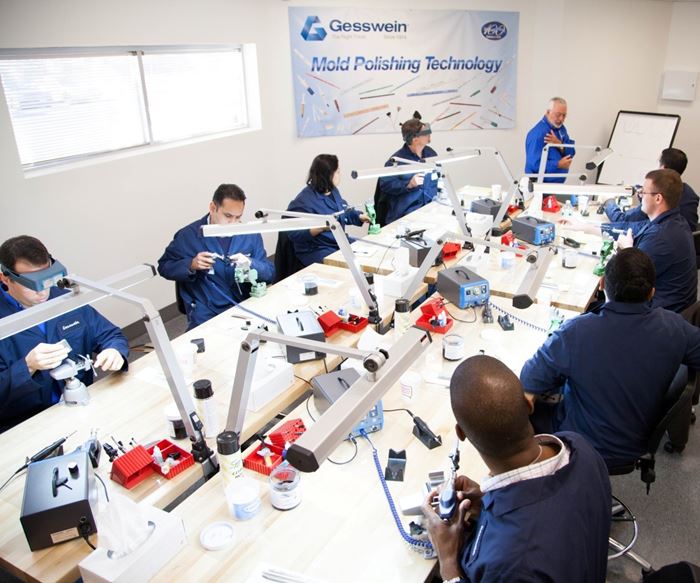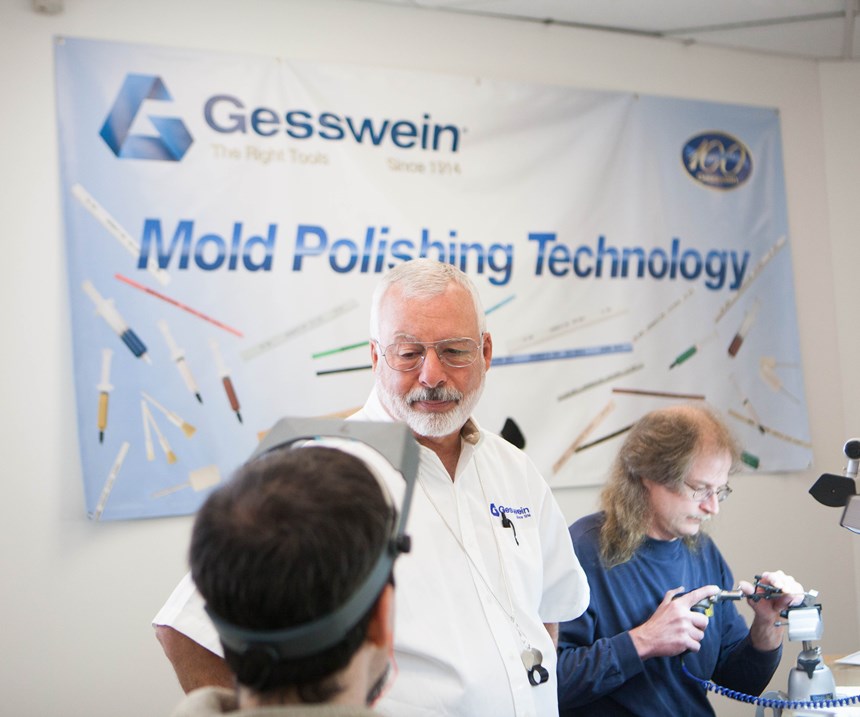Polishing Requires Local-Level Communication
A focus on machining and measuring when polishing saves time and improves part quality.
Share
Steve Smith considers himself a polishing coach. He is a big believer in taking work up to a very fine finish with abrasive stones using a crisscross method and then using a minimal amount of very fine diamond compound to do the final polishing. He learned this approach back in the 1970s, and it has served him very well throughout his career, including his current role as a polishing instructor.
“Polishing is simple; it’s more about how you apply it,” Smith says. His standard process involves using general-purpose, middle-of-the-road hardness stones. Depending on surface roughness, he typically begins with a 400-grit stone, then a 600-grit, a 900-grit and sometimes a 1200-grit for the required finish. “For example, if you're going to an SPI A1 finish, the finer the scratches (peaks and valleys) are before you go to a diamond compound (loose abrasive) from a stone (fixed abrasive), the less the pattern of the scratches will show through (orange peel),” Smith says. That's why he likes to go up to at least a 900-grit stone, and if it needs a super finish, he'll go one step further and use a soft 1200-grit stone.
Steel type and hardness dictate the process. Stones will rip and tear the surface of a 46 HRC 420 stainless steel or H13. So, going finer and softer will yield finer peaks and valleys. Material with a hardness up around 50-52 HRC will stone better. It will not rip and tear so that the polisher can get by with one less stoning operation, according to Smith.
Instead of Smith reviewing his step by step guide to polishing, I asked him to share some insight into a few of the critical factors that contribute to a quality polish.
Machining. Smith’s number-one rule is that “perform polishing in concert with machining.” Essentially, this takes communication and information. “Establishing the right culture to communicate properly is key. The machining department must know what the polishing department is facing upfront instead of relying on a ‘the polisher can fix it’ strategy,” Smith says. He recommends “going backward.” Going backward means that everyone has to help his or her internal customer, which is the person who follows you in the process. So, the machinist’s internal customer is the polisher, and the polisher’s internal customer is the actual customer, according to Smith.
The more a machinist helps the polisher, the better the product is going to be. Achieving a better product requires a conversation between the machinist and polisher. Knowing the required final dimension and required final polish at the start of the job is essential. You know the required finish, but what needs to be done to achieve that finish? Machinists often ask polishers how much stock they are going to take off to get a particular finish, but the answer is not that easy, according to Smith. The customer will get better parts if there is enough stock to polish.
For example, let’s consider EDM. Smith notes that often the machinist asks the polisher, “How much stock are you going to take off of the EDM finish? To which he replies, “Well, how deep are the EDM pits?” You can guesstimate how much stock you're going to take off, but it takes years of practice and measuring the surface for the machinist/polisher team to come up with the right answers. On top of that, many polishers have never actually measured the amount of material they take off to achieve a certain finish.
The more a machinist helps the polisher, the better the product is going to be.
Measuring. “Let's say you have to have a high polish with no scratches (an SPI A1 finish). You might start off with a 400-grit stone and follow that up with three or four more steps, so you need to know how much material you're going to take off with each step. If you've never measured it, you don't know. This takes time.” Smith says.
Although this does take time, it simply entails using measuring equipment, such as a dial indicator and finding out how much stock a polisher removes. The goal is not to achieve a certain size, but to measure with each step how much you remove from the surface and record that measurement to establish a history of how much you remove.
It’s a visual, manual method. You are always removing the preceding scratches that you put on. Smith recommends using a crisscross method. “Make all your scratches with a 400-grit stone in one direction, then when you move onto the 600-grit stone use it in a different direction, so you are removing the 400-grit stone scratches. You measure with the 400-grit then measure with the 600-grit, and you’ll calculate how much you removed,” Smith says.
The polisher, using a crisscross polishing method, sees the removed stock and can then easily measure it. Smith warns that sometimes the shape of the part prevents using the crisscross method. However, if the polisher has a history of the amount of removed stock, he or she can still measure and be fairly certain that they removed the preceding step.
Note that machinists and polishers must be honest about what they are measuring. Some people use an inspection sheet but wait until all the parts are finished and then place a checkmark all the way down the sheet without measuring each one. They make the mistake of measuring the first one and assuming the rest are all the same.
It's important for the polisher to know how much stock they take off, so they can share relevant information to the process to save time. It is essential to have a means of communicating that data. It's about the value of measuring and communicating that information to your internal customers, improving the process and satisfying the external customer.
About the Author
Steve Smith
In 1964 after high school Steve Smith started working at Wilkin's Mold Polishing, which was the only mold polishing shop in the western part of the U.S. that trained polishers. In 1972 they closed their doors. Smith moved to Samson Mold, a 20-person shop where he worked hand in hand with the EDM and grinding departments, learning the value of good communication. In 1979 he got an offer from Caco Pacific to run its polishing department. Five years ago, Smith retired but accepted a position as a consultant and instructor for Gesswein Company’s polishing course, which to date has taught 400 students across North America.
For More Information
For More Information
Gesswein Company
203-366-5400, ext 280
gesswein.com














.jpg;maxWidth=300;quality=90)


.jpg;maxWidth=970;quality=90)